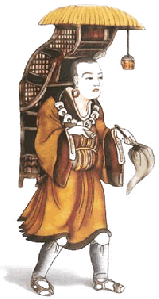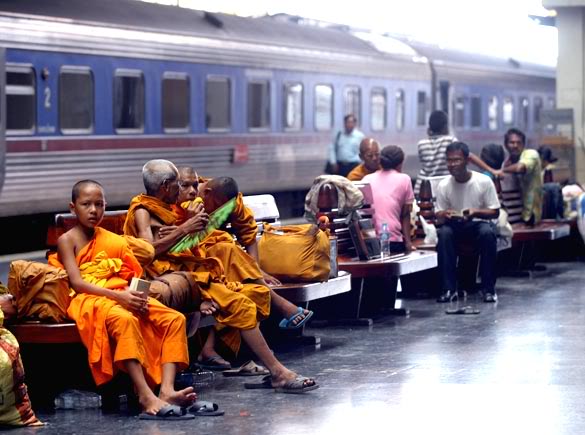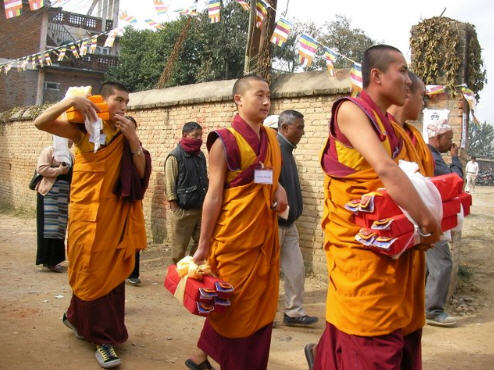
|
Student Activity Two: Voices of Pilgrims
Buddhist pilgrimage has been recorded since the time of the Buddha. The earliest accounts of pilgrimage are found in teachiugs from the Buddha, inscriptions from the time of King Asoka, and the writings of Chinese pilgrims. The following excerpts are a sampling of such writings. Analyze these texts by answering the questions below the execrpts. Document One: “He who pays homage to those who deserve homage, whether the awakened (Buddha) or their disciples, those who have overcome the host (of evils), and crossed the flood of sorrow, he who pays homage to such as have found deliverance and know no fear, his merit can never be measured by anybody.” Document Two: Another reference is found in the Mahaparinirvana Sutra (100CE to 220CE) “Ananda, there are four places the sight of which will arouse strong emotion in those with faith. Which four? Here the Tathagata (The Buddha or enlightened one) was born, this is the first place. Here the Tathagata attained Enlightenment, this is the second place. Here the Tathagata set in motion the Wheel of the Dhamma, this is the third place. Here the Tathagata attained final Nibbana (Nirvana) without remainder, this is the fourth place. The monk or nun, layman or laywoman, who has faith should visit these places. And anyone who dies while making a pilgrimage to these places with a devout heart will, at the breaking up of the body, be reborn in heaven.” (DN 16, PTS: D ii 137) Document Three: The first recorded account of Buddhist pilgrimage is found in the Ashokavadana ("Narrative of Ashoka"), a 2nd century CE text related to the legend of the Maurya Emperor Ashoka the Great. The legend was translated into Chinese by Faxian in 300 CE. Upagupta too (Ashoka) to the Lumbinio Grove and Then Asoka, wept and made a gesture of veneration and said, Asoka’s pilgrimage was commemorated by an inscription on a pillar at Lumbini. Document Four: According to a commentary to the Vinaya Sutra known as 'Lung-Treng-Tik' in Tibetan by the First Dalai Lama (1392-1474), the Buddha is said to have emphasized several times the importance of pilgrimage. "Bhikkhus, after my passing away, all sons and daughters who are of good family and are faithful should as long as they live, go to the four holy places and remember: Here at Lumbini, the enlightened one was born; here at Bodh Gaya he attained enlightenment, here at Sarnath he turned the wheel of Dharma; and there at Kusinara he entered Parinirvana. Bhikkhus, after my passing away there will be activities such as circumambulation of these places and reverence to them. Thus it should be told to them for they, who have faith in my deeds and awareness of their own, will travel to higher states. After my passing away, the new Bhikkhus who come and ask of the doctrine should be told of these four places and advised that a pilgrimage to them will help purify their previously accumulated Karmas or actions." Document Five: Faxian (337 – c. 422 CE) who was a Chinese Buddhist monk who traveled to India, Sri Lanka and Nepal, between 399 and 412 CE. His describes his journey in a travelogue called, “A Record of Buddhist Kingdoms, Being an Account by the Chinese Monk Fa-Xian of his Travels in India and Ceylon in Search of the Buddhist Books of Discipline.” Look at a 19th century translation of Faxian’s account of his travels. Document Six: Accounts of Chinese pilgrims to sites of the historical Buddha Faxian (337 – c. 422 CE) Student Activity Number Two: Voices of Pilgrims 1. Refer to documents 1-4 to answer the following: Where are these documents from? According to these documents, what are the benefits of pilgrimage to the pilgrim? 2. Refer to document #5 (pages 9-36; chapters 1-12 above) to answer the following:
3. Refer to document #6 (link to the PDF above) to answer the following: How were Faxian, Xuanzang and Yijing's experiences of pilgrimage different? How were they similar?
|
This site created by Mary Muenster and Sarah Fendrick at the NEH Summer Institute "Literatures, Religions, and Arts of the Himalayan Region", held at the College of the Holy Cross, Summer 2011.



